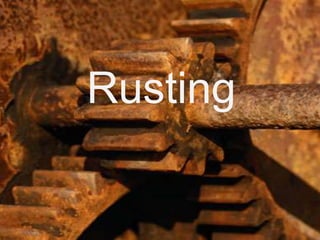Rust, how it occur
•Download as PPTX, PDF•
1 like•167 views
This slides simply explains how rust occur.
Report
Share
Report
Share

Recommended
Recommended
More Related Content
What's hot
What's hot (19)
Carbon Steel from 0 to Z ( Industrial Chemistry ) Part 1 

Carbon Steel from 0 to Z ( Industrial Chemistry ) Part 1
Similar to Rust, how it occur
Similar to Rust, how it occur (20)
vnd.openxmlformats-officedocument.presentationml.presentation&rendition=1.pptx

vnd.openxmlformats-officedocument.presentationml.presentation&rendition=1.pptx
How do oxides of phosphorus react with water- Why aluminum oxide is am.docx

How do oxides of phosphorus react with water- Why aluminum oxide is am.docx
two different ways the turbine blade is protected from oxygen during.pdf

two different ways the turbine blade is protected from oxygen during.pdf
Recently uploaded
Recently uploaded (20)
development of diagnostic enzyme assay to detect leuser virus

development of diagnostic enzyme assay to detect leuser virus
POGONATUM : morphology, anatomy, reproduction etc.

POGONATUM : morphology, anatomy, reproduction etc.
GBSN - Microbiology (Unit 3)Defense Mechanism of the body 

GBSN - Microbiology (Unit 3)Defense Mechanism of the body
Bhiwandi Bhiwandi ❤CALL GIRL 7870993772 ❤CALL GIRLS ESCORT SERVICE In Bhiwan...

Bhiwandi Bhiwandi ❤CALL GIRL 7870993772 ❤CALL GIRLS ESCORT SERVICE In Bhiwan...
Genetics and epigenetics of ADHD and comorbid conditions

Genetics and epigenetics of ADHD and comorbid conditions
Gwalior ❤CALL GIRL 84099*07087 ❤CALL GIRLS IN Gwalior ESCORT SERVICE❤CALL GIRL

Gwalior ❤CALL GIRL 84099*07087 ❤CALL GIRLS IN Gwalior ESCORT SERVICE❤CALL GIRL
Climate Change Impacts on Terrestrial and Aquatic Ecosystems.pptx

Climate Change Impacts on Terrestrial and Aquatic Ecosystems.pptx
Cyathodium bryophyte: morphology, anatomy, reproduction etc.

Cyathodium bryophyte: morphology, anatomy, reproduction etc.
FAIRSpectra - Enabling the FAIRification of Analytical Science

FAIRSpectra - Enabling the FAIRification of Analytical Science
Porella : features, morphology, anatomy, reproduction etc.

Porella : features, morphology, anatomy, reproduction etc.
Call Girls Ahmedabad +917728919243 call me Independent Escort Service

Call Girls Ahmedabad +917728919243 call me Independent Escort Service
Rust, how it occur
- 1. Rusting
- 2. Rust is a brownish-red substance that forms on the surface of iron or steel when it is exposed to damp air. The term used alone means iron rust, which consists mainly of hydrated iron oxide (3Fe₂0₃∙H₂O). Rust is formed by the union of the oxygen of the air with the iron by a process called oxidation. Rust not only corrodes the surface but it also weakens the metal. Rust is the result of the reaction between a metal and a non-metal.
- 3. We have previously seen how metals come to form lattices that consist of alternating layers of positively charged ions and free electrons. This layered structure of metal are presented:
- 4. Oxygen gas, O₂, consists of two atoms of Oxygen covalently bonded together. This is a fairly stable state for Oxygen but given the opportunity each Oxygen atom will absorb two electrons from elsewhere and have a full outer shell of 8 electrons without having to share.
- 5. We know that the metal Iron has loose electrons. We also know that each of the atoms in the oxygen molecule would prefer to have 8 electrons without having to share. Let's look at the process in a series of visual steps:
- 6. 1. First the oxygen gas molecules, O2, approach the metal:
- 7. 2. Then the Oxygen molecule breaks apart and each oxygen atom soaks up two of the metal's free electrons, forming the stable oxide ion:
- 8. 3. The metal lattice now has less electrons than it needs and so some of the positively charged Fe ions will be shed from the lattice.
- 9. 4. The loose +3 Fe ions and the stable O₂- ions combine to form the neutral compound Fe₂O₃, as follows. Note that this is an ionic compound (a metal and a non-metal together) and that all ionic compounds have an overall charge of ZERO:
- 11. And so a single particle of the rust Fe₂O₃ is formed. Since this does not form a perfect seal over the surface of the metal, further oxygen can get to the surface of the metal, and the rusting continues.
- 12. Finally, rust is… … the product of the transfer of electrons from the metal (loss of electrons is called oxidation) to the oxygen molecules (gain of electrons is called reduction).
- 13. 1. Place the ball of steel wool into a glass jar and add enough water to cover the ball.
- 14. 2. Add bleach and vinegar that has the ratio of 4:2, (this mixture is called hypochlorous acid), Stir.
- 15. 3. In about 5 minutes and on, the liquid is full of red powder. This powder is called ferric oxide (rust). Remove the steel wool from the jar and wait for the powder to settle so that you can see the red powder easily.
- 16. Steel wool rusts slowly in water, but quickly in a solution containing hypochlorous acid. In the experiment, the solution used was vinegar and bleach. The hypochlorous acid (HCIO) in the solution reacts with the iron (Fe) in steel wool to form hydrated ferric oxide (Fe₂O₃∙H₂O).
- 17. Hypochlorous Acid Hypochlorous acid is a weak acid with the chemical formula HClO. HClO is an oxidizer, and as its sodium salt sodium hypochlorite, (NaClO), or its calcium salt calcium hypochlorite, (Ca(CIO)2) used as a bleach and others.
- 18. Iron Like other Group 8 elements, iron exists in a wide range of oxidation states, −2 to + 6, although +2 and +3 are the most common. Fresh iron surfaces appear lustrous silvery- gray, but oxidize in normal air to give iron oxides, also known as rust. Unlike many other metals which form passivating oxide layers, iron oxides occupy more volume than iron metal, and thus iron oxides flake off and expose fresh surfaces for corrosion.
- 19. Small glass jar small ball of steel wool bleach Vinegar Water old spoon/ stick (for stirring) Measuring spoon (for measuring)—if possible